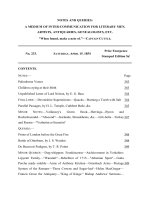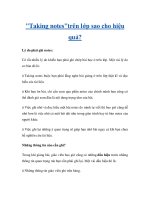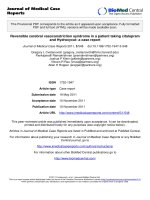Taking Notes and Outlining
Bạn đang xem bản rút gọn của tài liệu. Xem và tải ngay bản đầy đủ của tài liệu tại đây (97.2 KB, 15 trang )
91
CHAPTER
9
T
AKING
N
OTES
AND
O
UTLINING
Now that you’re getting
good at finding main and
supporting ideas, you can
begin to write effective
notes and outlines. This
chapter will show you
how to make the most
of these powerful
comprehension and
retention strategies.
T
aking notes and outlining are two effective
ways to keep track of the important ideas and information
conveyed in a text. They’re quite similar strategies. The main
difference is that outlines have a more formal structure than notes.
ASKING QUESTIONS AND TAKING NOTES
The secret to taking good notes is knowing what ideas and details are
important. Therefore, a good way to set yourself up for taking notes is
to ask the right questions.
Back in Chapter 1, you learned about pre-reading, in particular, about
reading the pre-text and about skimming ahead. By skimming ahead, you
READ BETTER
,
REMEMBER MORE
92
can look for headings, main topics, and key words that can help you orga-
nize your notes or outline. First, any words that are defined in the text
you’re reading should probably be included in your notes. Second, you can
use the pre-text and the various headings and divisions of a text to create
questions that can guide you through the note-taking or outlining process.
For example, look back at Chapter 3 for a moment. The title and all of
the main headings in the text of that chapter are listed below. Notice how
the title and the first heading are used to form questions using the who,
what, where, when, why, and how question words:
Using the Dictionary. How do you use one? When should you use
one? Why should you use one?
Read the Entire Definition. When should you read the entire defi-
nition of a word? Why should you read the whole definition? How
should you read it?
Use Context to Pick the Right Meaning
Parts of Speech
Special or Limited Definitions
How to Remember New Vocabulary
P
RACTICE
1
Formulate questions for the remaining section headings listed above.
Answers
Answers will vary. Here are some questions you might have created:
Use Context to Pick the Right Meaning. When do you need to use
context to pick the right meaning? How do you use the context to pick
the right meaning?
Parts of Speech. What are parts of speech? Why do I need to know
what they are? How can I tell them apart?
Special or Limited Definitions. What are special or limited defini-
tions? How can you tell them apart from “regular” definitions?
How to Remember New Vocabulary. How can I remember new
words? What tricks or strategies can I use?
TAKING NOTES AND OUTLINING
93
KEYS TO TAKING GOOD NOTES
Good notes will answer many of your pre-reading questions. Specifically,
good notes will:
1
. Explain key terms
2
. List main ideas
3
. List major supporting ideas but not minor ones
For example, notes on the section in Chapter 3 entitled “Read the
Entire Definition” might look something like this:
•
Always read the whole definition
•
Words often have more than one meaning
•
Definition includes these three things:
(1)phonetic spelling (how word is pronounced)
(2)part of speech
(3)meanings
P
RACTICE
2
Write notes for any section of Chapter 3. Use your questions and the
guidelines above.
Answer
Answers will vary because you will be putting some ideas into your own
words. Here are possible notes for the topic parts of speech:
•
Parts of speech describe the function of a word. There are four
main parts of speech:
1
. A noun is a person, place, or thing (beach).
2
. A verb is an action (shout).
3
. An adjective describes a noun (happy).
4
. An adverb describes a verb, an adjective, or another adverb
(very, happily).
•
The meaning of a word depends upon its part of speech.
•
Use context to determine a word’s part of speech (how is it used
in the sentence?)
READ BETTER
,
REMEMBER MORE
94
Notice that these notes include the definition of each part of speech as
well as one example.
P
RACTICE
3
If you bought this book, that means you really want to improve your read-
ing retention. So let’s make the most of your money by helping you remem-
ber more of what you’ve read in this book. Remember, any time you write
something down, you help to seal it in your memory. And any time you go
back to an idea, you reinforce your memory and understanding of it.
Choose any part of any chapter so far (except Chapter 5) and take
notes on it. Make sure it’s a substantial part—at least a full page. For
example, the following sample notes were taken from the first part of
Chapter 6,“Finding the Main Idea.”You should start by asking questions.
Write your notes on a separate sheet of paper.
Answer
Your notes, of course, will depend upon what chapter and section you
chose. Here are notes from Chapter 6. First is a list of questions one
might ask from pre-reading. Then the notes for the section follow.
1
. What is a main idea?
2
. What is a topic sentence?
3
. What are the characteristics of main ideas?
4
. Where do I find topic sentences?
5
. How are main ideas in paragraphs different from main ideas in essays?
6
. How can main ideas help me remember what I read?
Here are the notes that answer the questions above:
1
. The main idea is the overall fact, feeling, or thought the writer wants
to convey about her subject.
2
. Topic sentences are sentences that clearly express the main idea.
3
. Main ideas:
a
. Say something about the subject
b
. Are general enough to be an “umbrella” for the passage
c
. Are assertions (claims that require evidence)
TAKING NOTES AND OUTLINING
95
4
. Topic sentences are often at the beginning of paragraphs, but they can
be anywhere.
5
. Main ideas of paragraphs work to support the overall main idea
(thesis) of an essay.
6
. Main ideas are the most important thing to remember.
OUTLINING
Outlining is very similar to note-taking. The main difference is that outlines
are more structured than notes. That is, there’s a certain way outlines should
be organized. By organizing information the way they do, outlines help you
remember ideas and information and see the relationships between those
ideas. In an outline, you can see exactly which ideas each sentence supports.
The basic structure for an outline is this:
I. Topic
A. Main idea
1. Major supporting idea
a. Minor supporting idea
Outlines can have many layers and many variations, but this is essen-
tially how they work: you start with the topic, move to the main idea, add
the major supporting idea, and then list minor supporting ideas (if
they’re important enough to write down).
A typical paragraph might be outlined like this:
I. Topic
A. Main idea
1. Major supporting idea
a. Minor supporting idea
b. Minor supporting idea
2. Major supporting idea
a. Minor supporting idea
b. Minor supporting idea
3. Major supporting idea
a. Minor supporting idea
b. Minor supporting idea
READ BETTER
,
REMEMBER MORE
96
When you’re working with a larger text, the overall main idea (thesis)
should be at the top. Here’s an example:
Ebonics controversy (topic)
I. Ebonics is more than just slang (thesis)
A. Ebonics has distinct grammar patterns.
a. Verbs are formed in a systematic way
(1)The s is dropped in the third person (“He say”)
b. Use of “be” instead of “is”
(1)For Example: “That be his car”
B. Ebonics has its own pronunciation rules
a. sk is pronounced x
b. th is pronounced f
Outlining a text enables you to see the different layers of ideas and
how these work together to support the overall main idea. When you
outline, you do not have to include the minor supporting ideas, though
you certainly may choose to do so.
P
RACTICE
4
Outline part of any chapter you’ve completed so far. You might want to
outline the section you had the most difficulty with. Outlining will help
you remember and better understand the ideas in that chapter.
Answers
As usual, answers will vary. Here is an outline of Chapter 7:
I. Supporting ideas (topic)
A. Supporting ideas support a main idea like legs support a table
(thesis)
1. Main idea tells; supporting ideas show.
2. Types of support include details, facts, statistics, etc.
3. Distinguish main idea from support
a. Signal words often introduce supporting ideas.
(1)Examples: accordingly, also, as a result, furthermore, first
of all, for example, etc.









